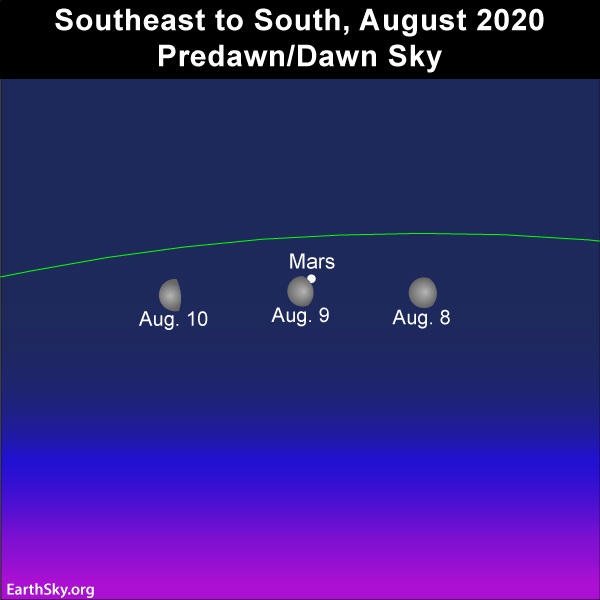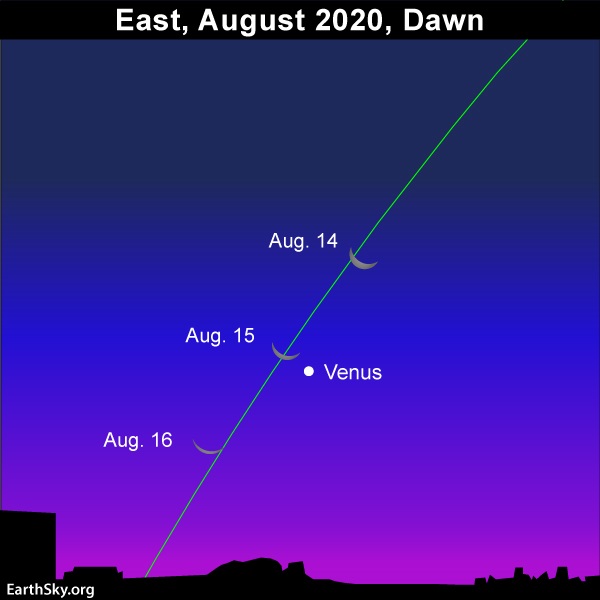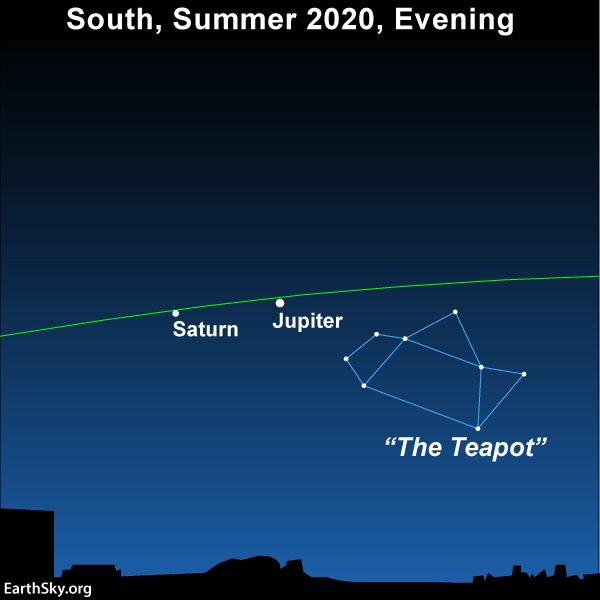
On August 7, 8 and 9, 2020, look eastward before going to bed, and you might just catch the waning gibbous moon and red planet Mars. After this brilliant twosome rises, the moon and Mars will travel westward across the nighttime sky. They’ll reach their high point for the night at or near morning dawn.
For many months now, Mars has been either absent from our sky or inconspicuous. But now Mars is brightening, day by day, as Earth sweeps up from behind Mars in our smaller, faster orbit. By September 2020, our faster motion will have brought us even nearer to Mars. The red planet will then outshine Sirius, the brightest star in our sky (besides the sun). In October – when Earth will sweep between the sun and Mars, bringing Mars to its every-other-year opposition – Mars will outshine not only all the stars, but also Jupiter, the second-brightest planet.
Mars will beam at its brightest and best for the year in mid-October 2020. At that time, the red planet will shine about 3 1/2 times more brightly than it does now.
That’s why now is a good time to start watching Mars! It’s already quite bright and lots of fun to see …

If you’re more of an early bird than a night owl, look for the moon and Mars much higher up in the sky before sunup this weekend. Note: the moon appears larger on the sky chart than it does in the real sky.
Like to get up early? Look for the moon and Mars around their highest in the sky before dawn. Better yet – in those early-morning hours – you’ll also enjoy an eyeful of Venus, the brightest planet of them all, basking in the light of the sun in the eastern morning sky. Venus ranks as the third-brightest celestial object in all the heavens, after the sun and moon, respectively. In fact, sharped-eyed folks can even see Venus with the eye alone in a daytime sky.
Mars and the moon high up at dawn, with Venus blazing in the east! What could be better? Well … maybe a meteor? The Perseid meteor shower is now rising to its peak. If you’re under a dark sky, you might catch one sweeping in the predawn.
Read more: All you need to know about 2020’s Perseid meteor shower

After the moon meets up with Mars around August 9, it’ll go past Venus around August 15. Read more.
If you’re up before dawn and have an unobstructed view east and west, you might also catch Jupiter and Saturn in the southwest sky. Thus, at this early hour, you might catch four bright planets at one time: Mars near the moon, Venus in the east, and Jupiter and Saturn in the southwest.
More likely, it’ll be easier to catch Jupiter and Saturn in the evening sky, because the these two planets pop out first thing at nightfall and stay out nearly all night long.

Jupiter and Saturn climb highest up for the night at mid-to-late evening in early August, and by early-to-mid evening by the month’s end.
Mars, though not as bright as Venus or Jupiter, is nonetheless brilliant and beautiful and a wonder to behold. In fact, at present, Mars presently ranks as the sixth-brightest celestial body, after the sun, moon, Venus, Jupiter and the star Sirius, respectively. Depending on where you live worldwide, you might – or might not – see Sirius in the August morning twilight; it has just begun to climb out of the glare of sunrise.
Have fun, sky-watchers!
Bottom line: Use the moon to find Mars on the nights of August 7 to 9. Then keep watching this fiery world as it lights up the nighttime for the rest of this year. The year 2020 showcases Mars’ brightest performance until the year 2035. Don’t miss out!
from EarthSky https://ift.tt/2DI45GC

On August 7, 8 and 9, 2020, look eastward before going to bed, and you might just catch the waning gibbous moon and red planet Mars. After this brilliant twosome rises, the moon and Mars will travel westward across the nighttime sky. They’ll reach their high point for the night at or near morning dawn.
For many months now, Mars has been either absent from our sky or inconspicuous. But now Mars is brightening, day by day, as Earth sweeps up from behind Mars in our smaller, faster orbit. By September 2020, our faster motion will have brought us even nearer to Mars. The red planet will then outshine Sirius, the brightest star in our sky (besides the sun). In October – when Earth will sweep between the sun and Mars, bringing Mars to its every-other-year opposition – Mars will outshine not only all the stars, but also Jupiter, the second-brightest planet.
Mars will beam at its brightest and best for the year in mid-October 2020. At that time, the red planet will shine about 3 1/2 times more brightly than it does now.
That’s why now is a good time to start watching Mars! It’s already quite bright and lots of fun to see …

If you’re more of an early bird than a night owl, look for the moon and Mars much higher up in the sky before sunup this weekend. Note: the moon appears larger on the sky chart than it does in the real sky.
Like to get up early? Look for the moon and Mars around their highest in the sky before dawn. Better yet – in those early-morning hours – you’ll also enjoy an eyeful of Venus, the brightest planet of them all, basking in the light of the sun in the eastern morning sky. Venus ranks as the third-brightest celestial object in all the heavens, after the sun and moon, respectively. In fact, sharped-eyed folks can even see Venus with the eye alone in a daytime sky.
Mars and the moon high up at dawn, with Venus blazing in the east! What could be better? Well … maybe a meteor? The Perseid meteor shower is now rising to its peak. If you’re under a dark sky, you might catch one sweeping in the predawn.
Read more: All you need to know about 2020’s Perseid meteor shower

After the moon meets up with Mars around August 9, it’ll go past Venus around August 15. Read more.
If you’re up before dawn and have an unobstructed view east and west, you might also catch Jupiter and Saturn in the southwest sky. Thus, at this early hour, you might catch four bright planets at one time: Mars near the moon, Venus in the east, and Jupiter and Saturn in the southwest.
More likely, it’ll be easier to catch Jupiter and Saturn in the evening sky, because the these two planets pop out first thing at nightfall and stay out nearly all night long.

Jupiter and Saturn climb highest up for the night at mid-to-late evening in early August, and by early-to-mid evening by the month’s end.
Mars, though not as bright as Venus or Jupiter, is nonetheless brilliant and beautiful and a wonder to behold. In fact, at present, Mars presently ranks as the sixth-brightest celestial body, after the sun, moon, Venus, Jupiter and the star Sirius, respectively. Depending on where you live worldwide, you might – or might not – see Sirius in the August morning twilight; it has just begun to climb out of the glare of sunrise.
Have fun, sky-watchers!
Bottom line: Use the moon to find Mars on the nights of August 7 to 9. Then keep watching this fiery world as it lights up the nighttime for the rest of this year. The year 2020 showcases Mars’ brightest performance until the year 2035. Don’t miss out!
from EarthSky https://ift.tt/2DI45GC

Aucun commentaire:
Enregistrer un commentaire